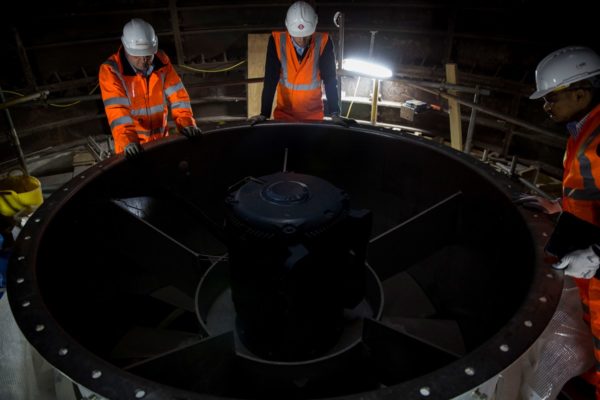Waste heat from the London Underground is now being used to provide heating and hot water to more than 1,350 homes, a school and two leisure centres in Islington. The heat is being extracted from the Northern line through a ventilation shaft built in the disused City Road tube station, and is then added to Islington council’s existing local heat and energy system.
The remains of the long closed tube station have been transformed to house a huge underground fan which sucks out warm air from the Northern line tunnels below. The warm air is used to heat water that is then pumped to buildings in the neighbourhood through a new 1.5km network of underground pipes.
During the winter months, a fan in the ventilation shaft extracts warm air from the Tube which travels over a series of water-filled pipes, heating the water inside by a few degrees. The water temperature is then increased to about 80c using heat pumps, which is suitable for domestic and commercial central heating systems. The fan also has the potential to operate in reverse to supply cooler air to the Tube tunnels during the summer months.
The hot water is pumped around a network of insulated underground pipes, and the heat is again transferred to communal heating system loops on housing estates using heat exchangers.
The centre’s combined heat and power technology means it also generates cheaper, greener electricity that is fed into the London Underground network and an adjacent tower block, powering its communal lighting and lifts.
They’ve been working on the project since 2012 – when a communal heat system was set up to generate local heat and energy.
The formal agreement was then signed in 2017 to extract heat from the London Underground.
The existing Bunhill district heating network already heats more than 800 homes and two leisure centres in south Islington. The new centre hooked up another 550 homes and a primary school, serving a total of 1,350 homes. The network now has the potential to supply up to 2,200 homes.
TfL has also undertaken a study on 56 ventilation shafts to assess the potential of each for exporting waste heat. Detailed technical feasibility studies have been completed for the top six sites and TfL is developing its strategy to move these sites forward.











What are the top 6 sites TfL are planning to progress?
Unknown.
The 2 min video How an abandoned Tube station is heating London’s homes by reporter Jamie Moreland which was shown in BBC1 London News last Friday which I can no longer find on the BBC website,you can watch on BBC London channel on youtube,he visited the City Road Tube station and showed the shafts,pipes,tank ect.
The fan wouldn’t need to operate in reverse to supply cooler air in summer, unless it’s sending in refrigerated air which seems unlikely. If it continues to suck out the hot air, air pressure means that cooler air from outside the tunnels will come in anyway somewhere down the line.
So why do you think they are doing it?